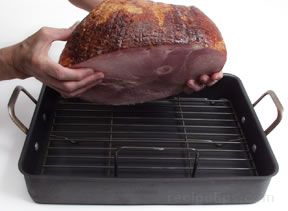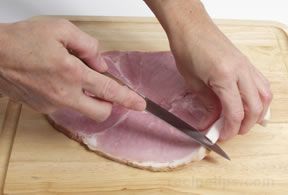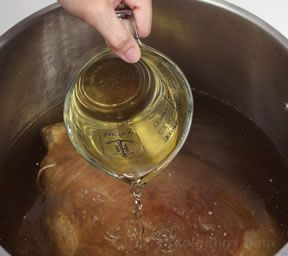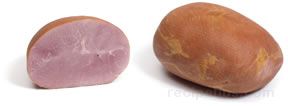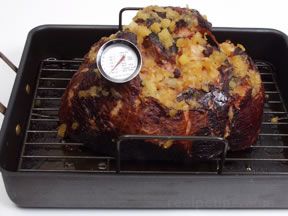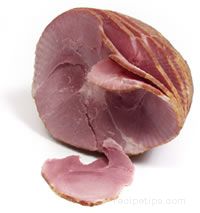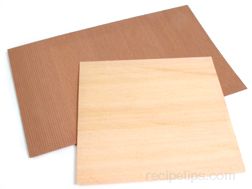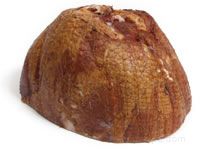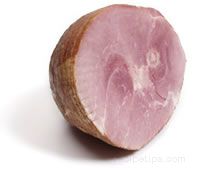|
Grilling ham is generally done outdoors with the heat applied on the bottom surface of the meat. Grilling infuses the ham with a smoky flavor from the juices dripping on the charcoals. Smaller cuts are best when grilling ham because the larger cuts are harder to thoroughly cook without overcooking the outer surface. Try one of our grilled ham recipes to see what a great flavor grilling provides for the ham. For more information, search our Grilling section to see more detailed information on grilling ham.
How to Grill Ham
There are two basic types of grilling that are used, indirect grilling and direct grilling.
Indirect heat: A method of grilling where you use an area of the grill that is not directly over the heat source. Using indirect heat slows the cooking process down, which allows the center of the cut to cook thoroughly without burning the outer surface. Coals are pushed to one side of the grill or banked into a ring around the outer edges to provide an area of indirect heat. On gas grills, the side of the burner, which is below the area where the food will be, is turned off after the grill is preheated. This will provide an area on the grill that will be a low heat source. The meat is placed over the area in which there are no coals or over the burner that is turned off on a gas grill. The meat is generally cooked with the grill hood closed. Indirect heat would be used for cooking larger cuts of meat, such as whole and half hams.
Direct heat: A method of grilling where you cook the meat directly over the heat source. The meat is cooked quickly over medium coals and should be watched carefully to prevent overcooking. The meat cooked using direct heat can be cooked with the hood up but is generally cooked with the hood down. The ham is generally turned once during the cooking process. Direct heat is good for cooking smaller cuts, such as ham slices.
Grilling is ideal for cooking smaller ham cuts, such as ham slices. It is not the best-suited method for cooking a whole or half ham. Because grilling uses high heat and short cooking times, a whole or half ham will become overcooked on the outside before the inside reaches the proper temperature.
Ham slices that are going to be grilled should be a minimum of 1 inch thick and no thicker than 2 inches. Trim the skin from the outer edge but leave a layer of fat. When grilling ham slices, keep the slices flat by clipping the fat around the edges at 1 to 1 ½ inch intervals. Allow the ham to stand at room temperature for approximately 30 minutes before placing on the grill. The grill should be at a medium heat. Place the ham slices on the grill approximately 4 inches above direct heat. Leaving the hood open, cook for 6 to 10 minutes on both sides or until each side is nicely browned.
The heat from the grill will cook the ham quickly and if the cuts are too thin, they will overcook, causing them to dry out. The ham must be watched carefully while grilling. Coating the ham slices with a little oil or marinating it before cooking will help keep it moist. It is important that the heat source be properly preheated so that it seals the juices into the meat quickly. The temperatures at which the ham is cooked and the distance it is from the heat source are both important in producing tender, juicy, properly done ham.
To check the temperature of the grill, place the palm of your hand at the cooking level above the heat source. If you can leave it there for 5 or 6 seconds the grill will cook at a low to medium low heat. If your hand must be pulled away after 3 seconds it is at a medium heat, and if it can only be left there for 2 seconds the temperature is hot. The thicker the ham slice the farther away from the heat source it should be or the heat source should be at a lower temperature to prevent the outside of the ham from burning before the inside is properly cooked.
To help prevent the ham slices from sticking to the grate on which they will be placed, the grate can be brushed with oil and the grill should be properly preheated before placing the meat on the grate. While the meat is cooking be sure to watch the pieces carefully, turning when one side is nicely browned. It is generally suggested to turn the cuts only once. Also, do not overcrowd the pieces so that if there are flare-ups from the drippings there is room to move pieces out of the way of the flames.
Grilling Tips:
- Preheat grill to proper temperature to ensure the meats surface is seared quickly to seal in juices.
- Using clean racks and coating them with vegetable oil or a nonstick vegetable oil spray will help prevent the meat from sticking.
- To keep ham slices flat while grilling, clip fat around the edges at 1 to 1 ½ inch intervals.
- Do not use a fork to turn the ham as it cooks. The piercing causes juices to escape. Use tongs to turn.
- Leave an area of a charcoal grill without coals so that if a flare up occurs or some of the meat is cooking too quickly, you can move the meat to this area. On a gas grill, leave one burner on low.
| 





